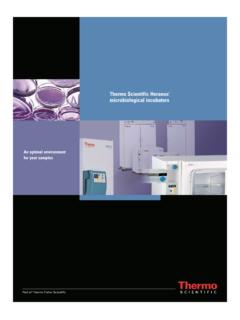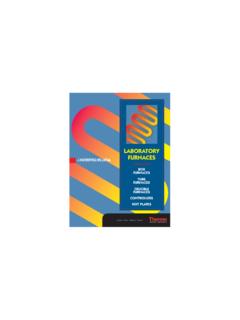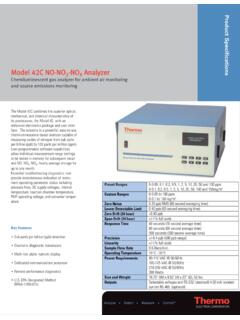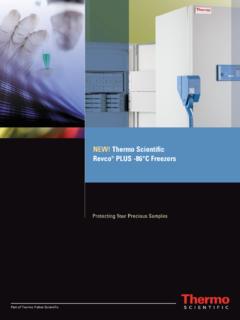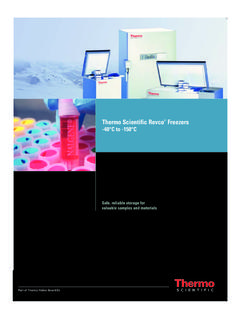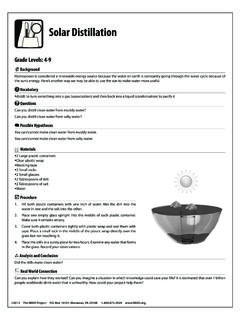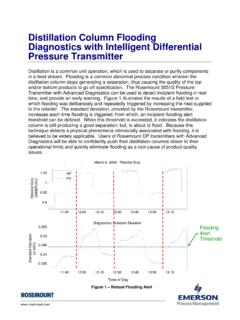Transcription of Simulated Distillation of Petroleum Products
1 Simulated Distillation of Petroleum Products (ASTM D2887) by GC in less than two minutesRiccardo Facchetti, Andrea Cadoppi Thermo Electron Corporation, Milan, ItalyApplicationNote: 10074 Key Words SimDist ASTM D2887 80 SecondsAnalysisIntroductionSimulated Distillation is a GC method used to characterizepetroleum fractions and Products , since it permits thequick determination of their boiling range are analyzed on a non polar chromatographiccolumn that separates the hydrocarbons in order of theirboiling points. These are correlated with the retentiontimes, through a calibration curve obtained by runningunder the same conditions a known mixture ofhydrocarbons, usually n-alkanes, covering the boilingrange expected in the sample.
2 Results are reported as acorrelation between the boiling points and the percentagesof the sample eluted from the determination of the boiling range distribution ofpetroleum fractions by conventional GC is a rapidanalytical tool, which is widely used to replaceconventional Distillation methods for control of refiningoperations and specification TechnologyThe huge demand of samples to be analyzed every day bylabs in the petrochemical industry requires an increasedspeed of analysis. An impressive gain in analysis speed compared to theconventional GC procedure is obtained through Ultra FastGas Chromatography. Ultra Fast GC implies the use ofshort (2-10m) narrow bore capillaries and temperatureprogramming conditions usually faster than 2 C/s.
3 Thisleads to peak widths in the 50-200ms range. The analysistimes are in the range of 1 minute or even rates in the range 2-20 C/s are notachievable with conventional GC ovens but only throughdirect resistive heating of the capillary columns. The new technology developed by Thermo ElectronCorporation is based on the Ultra Fast GC system, that isa dedicated configuration of Trace 1: system incorporates an ultra fast column moduleUFM (Figure 1) consisting in a fused silica column coiledalong with a heating element and a temperature sensorsuch to insure the direct resistive heating of the capillarycolumn. The assembly is held in an easy to handle metalcage. This permits to achieve temperature programmingrates up to 20 C/s, or even more, and to reach hightemperatures of 370 C.
4 Being placed inside the oven of aconventional Trace GC (see Figure 2), the Ultra FastModule cools down fast (around 1 minute from 350 C to40 C) by automatically activating the oven fan at the endof the temperature programming period or finalisothermal run. Capillary columns with a broad range oflengths and diameters can be incorporated in the column module inlet is installed on the split-splitlessinjector and the outlet on a Fast 2: Trace GC with and ResultsSimulated Distillation of ASTM D2887 Reference Oil wasperformed by Ultra Fast GC. To take advantage of thehigh heating rates of the Direct Resistive Heating modulea RTX-1 column, 5m long, mm , mm filmthickness was used.
5 The column temperature was programmed from 40 C(12 sec) to 350 C (18 sec) at a heating rate of 5 initial isotherm was needed to achieve the correctelution of the hydrocarbons with lower boiling injector was used in split mode. The injectortemperature was set at 280 C while the detector (fastFID) heating block temperature was set at 350 ability of the system to achieve excellentrepeatability on retention times and peak areas and onSimulated Distillation results has been repeatability test has been performed injecting acalibration mixture of n-alkanes C6-C44. In Figure 3 a calibration chromatogram is results reported in Table 1 point out the excellentperformances of the system in terms of repeatability ofretention times and peak 3: Calibration TIME (SEC)RT ST.
6 DEV (SEC)AREA ST DEV% 1: Repeatability test results. Data are based on 10 ASTM Reference Oil was diluted in CS2. 1 l wasinjected in split mode. A chromatogram of ASTM D2887reference oil is shown in Figure 4, superimposed on thecalibration chromatogram is compared with that achievedby conventional GC SimDist procedure. The Ultra FastGC analysis is 20 times 4: Ultra Fast Simulated Distillation of ASTM D2887 Reference Oil andcomparison of the same analysis performed in conventional order to evaluate the precision and the accuracy ofthe results, various Simdist analyses have been performed. The software processes the data following theprocedure described in the ASTM D2887 [1] Fast Gas Chromatography, being able togenerate peak widths of 100 msec, needs a specialsoftware for Simdist analysis, able to operate with verythin slices.
7 The data shown have been obtained usingSimdiChrom Software, optimized to operate with slices asnarrow as 10 msec. The boiling points distributions obtained with UFGCSimDist, reported in Table 2 and in Figure 5, show anexcellent repeatability, and fit perfectly with the dataobtained by using conventional conditions. The data arein good agreement with the ASTM D2887 reference oilboiling range distribution data provided by OFF BOILING POINT ( C)REFERENCE DATARUN 1 RUN (IBP)1151121125%15114814710%17617317515% 20119719820%22422122025%24324124030%2592 5525635%27527127240%28928728845%30229829 950%31230930855%32131831860%33232933065% 34333934070%35435035275%36536236380%3783 7437685%39138838790%40740440495% 2: Boiling points distribution of ASTM D2887 Reference Oil by UltraFast GC SimDist.
8 IBP=Initial Boiling Point - FBP=Final Boiling PointFigure 5 ConclusionUltra Fast GC Simulated Distillation of petroleumproducts can be achieved by using the system developedby Thermo, based on direct resistive heating of thecapillary columns. The analysis can be performed 20 times quicker thanin conventional GC without loosing performances interms of precision and accuracy. The method complies with ASTM D2887, StandardTest Method for Boiling Range Distribution of PetroleumFractions By Electron Milan, Italy is ISO Certified. 2004 Thermo ElectronCorporation. All rightsreserved. All trademarks are the property of ThermoElectron Corporation and its , terms andpricing are subject tochange.
9 Not all Products areavailable in all consult your localsales representative addition to these offices, Thermo Electron Corporation maintains a network of represen-tative organizations throughout the +61 2 9898 1244 Austria+43 1 333 50340 Belgium+32 2 482 30 30 Canada+1 800 532 4752 China+86 10 5850 3588 France+33 1 60 92 48 00 Germany+49 6103 4080 Italy+39 02 950 591 Japan+81 45 453 9100 Netherlands+31 76 587 98 88 Nordic+46 8 556 468 00 South Africa+27 11 570 1840 Spain+34 91 657 4930 Switzerland+41 61 48784 00UK+44 1442 233555 USA+1 800 532 12/04C
